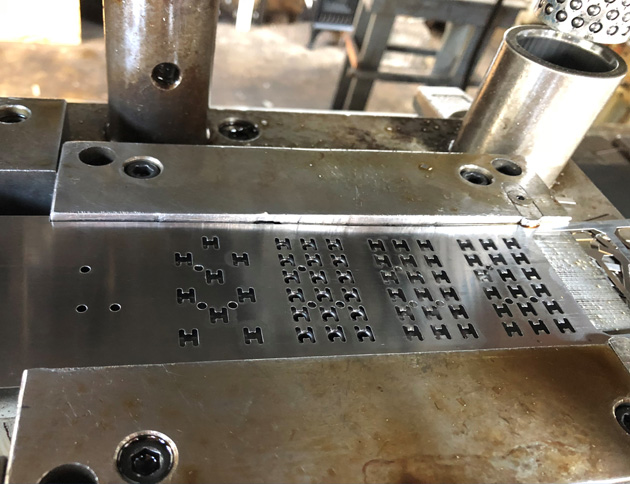Just How Metal Stamping is Revolutionizing the Automotive and Aerospace Industries
The Evolution of Steel Stamping Procedures: Technologies and Applications
The world of steel stamping procedures has actually witnessed a transformative journey noted by consistent advancement and adaptation to meet the needs of modern-day industrial methods. The applications span across a range of industries, each profiting uniquely from the improvements in steel stamping procedures.
Traditional Steel Stamping Methods
Typical metal stamping techniques have actually long been the foundation of making processes in various sectors because of their performance and accuracy. The process includes forming a steel sheet or coil into a preferred form by pressing it between a die and a punch. This method is extensively made use of for generating big quantities of parts with high accuracy at a fast speed.
One of the key advantages of standard steel marking methods is the capability to keep limited resistances, making certain that each component fulfills the needed requirements continually. This degree of accuracy is necessary in sectors such as auto, aerospace, and electronic devices, where also minor discrepancies can result in considerable issues.
Furthermore, conventional metal stamping techniques offer cost-effective solutions for automation contrasted to various other making approaches. The capacity to mark parts in fast sequence reduces production time and lowers labor expenses, making it an appealing option for businesses aiming to enhance their manufacturing processes.
Appearance of High-Speed Stamping

One of the vital advantages of high-speed marking is its capacity to maintain accuracy and consistency also at increased handling speeds. This accuracy is critical in sectors where tight tolerances and complex designs are required. Additionally, high-speed marking enables the processing of a wide array of products, including light weight aluminum, stainless-steel, and copper, further increasing its applicability throughout different markets.
Additionally, the introduction of high-speed marking has actually allowed manufacturers to meet the expanding demand for complicated parts in sectors such as automobile, aerospace, and electronics (Metal Stamping). By leveraging the rate and precision of high-speed marking technology, companies can improve their competition in a swiftly advancing market landscape
Improvements in Tooling Modern Technology
With the development of high-speed stamping allowing enhanced precision and efficiency in metal forming procedures, the area of steel stamping has seen significant advancements in tooling technology. Tooling modern technology plays a critical duty in steel marking procedures, influencing elements such as product top quality, manufacturing speed, and total cost-effectiveness.
By utilizing these sophisticated products, tooling suppliers can produce dies and mold and mildews that hold up against the high pressures and temperatures included in steel marking procedures, resulting in longer tool life and improved production effectiveness. Generally, these advancements in tooling innovation have actually changed the steel marking industry, allowing producers to accomplish greater degrees of accuracy, performance, and cost savings.
Combination of Automation in Marking
As automation remains to reshape the landscape of metal marking procedures, the assimilation of automated systems has actually come to be increasingly prevalent in modern manufacturing centers. Automated systems offer numerous benefits in metal stamping, consisting useful reference of increased efficiency, improved accuracy, and enhanced safety. By integrating automation into stamping processes, manufacturers can decrease cycle times, lessen material waste, and optimize production throughput.
Among the vital elements of automation in stamping is making use of robotic arms for tasks such as product handling, component control, and high quality assessment (Metal Stamping). These robotic systems can carry out repetitive and labor-intensive jobs with rate and precision, about his liberating human drivers to concentrate on even more complicated procedures. In addition, automation permits real-time surveillance and change of marking procedures, causing higher general procedure control and quality control
Additionally, the combination of automation in marking makes it possible for producers to attain constant part top quality, satisfy tight tolerances, and boost total efficiency. As technology remains to advance, the function of automation in metal marking processes is expected to increase even more, driving development and performance in the production market.
Applications Throughout Diverse Industries
Incorporating steel marking procedures across varied markets showcases the versatility and versatility of this manufacturing technique. From vehicle to aerospace, electronic devices to clinical gadgets, steel marking plays an important duty in the production of a wide variety of components. In the vehicle sector, steel marking is used to create elaborate components such as body panels, framework parts, and engine components with high accuracy and efficiency. The aerospace industry depends on steel marking for manufacturing lightweight yet long lasting elements for airplane and spacecraft. In the electronic devices market, steel stamping is crucial for generating connectors, contacts, and various other small components with limited resistances. Clinical gadget suppliers make use of steel marking for producing exact elements like surgical instruments and implants. Additionally, the appliance industry advantages from steel marking processes to produce parts for fridges, cleaning makers, and various other home appliances. The adaptability of metal marking procedures makes it a beneficial production method across various industries, demonstrating its relevance in modern-day manufacturing processes.
Verdict
